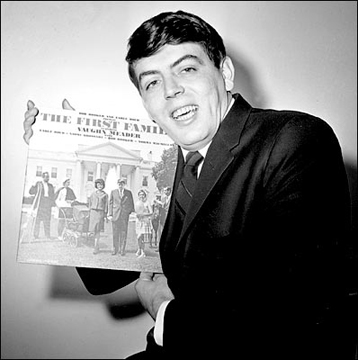
After the assassination of JFK in 1963, Lenny Bruce said, “They put two graves in Arlington—one for John Kennedy and one for Vaughn Meader.” Meader was a pitch-perfect Kennedy impersonator whose 1962 The First Family LP, a gently satirical look backstage in Kennedy’s White House, was a nationwide hit. His star fell on the death of the president; a mourning nation suddenly lost interest, and his life became a straight-to-video biopic (drug abuse, failed attempts to restart his career, obscure death). Meader’s story has acquired added resonance over the last week, as comedians whose income depended almost entirely on the verbal gaffes and political wrongdoings of the outgoing administration were asked whether or not they could survive without the choice material provided by the president. It has been amazing to hear suggestions that we are facing the end of a comedic golden age, that Barack Obama’s ascendance to the presidency will announce the death of a certain kind of satire, one which has also animated much political art and theatre over the last eight years. As the smoke clears and the helicopter blades thrum into the distance, however, it’s starting to look more and more as though we’ll see a resurgence, not a slump, in politically engaged culture over the next four years (and, hopefully, beyond).
With a few notable exceptions, the Bush administration has been detrimental to cultural dissent, not because of the censorship of anti-Republican views by cultural figures (Dixie Chicks) but because it obliged an engagement on its own terms. Bush’s debasement of political discourse and distrust of perceived intellectual superiority forced the hand of dissenters to such an extent that most satirical responses to Bush’s administration were as heavy-handed and broadly drawn as their targets. Political theatre, for example, saw a revival in the past eight years, but (with some notable exceptions) leaned towards a conceited cartoonishness, portraying Bush as a dunderheaded idiot with Rumsfeld as his cackling sidekick. The late Harold Pinter, one of the great writers of the last century, produced a body of anti-Bush poems that eschew his usual linguistic subtlety for sledgehammering outrage. Comedians, perhaps browbeaten by Bush’s propensity for self-satire, often relied on crude caricature shot through with a mixture of smugness and despair.
In these times of obfuscation and willful idiocy, much political art has swung either towards ham-fisted satire (Banksy, Savido, etc.) or theoretical obscurity, with the best instances of political art finding a kind of timeless depth and pathos in the issues of the day. This has always been the case with politically engaged art, of course (Goya, Picasso, Gonzales-Torres), and the art of greatest political resonance during Bush’s administration was that which dared to elevate itself from the petty scrabble of left and right and make statements of ahistorical resonance.
President Obama has already raised the level of public discourse in American politics. In doing so he has set the bar high for politico-cultural engagement. Political art, in all its forms, will improve—not dwindle—in his administration, but it will need to find its voice again. On an end note, remember the words of one of the last century’s most devastating voices of dissent, Isaac Babel: “No iron can pierce the heart with such force as a period put at just the right place.”



